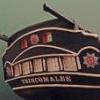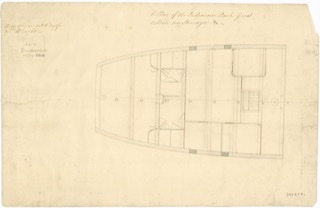-
Posts
546 -
Joined
-
Last visited
Content Type
Profiles
Forums
Gallery
Events
Everything posted by Morgan
-
I remember buying this kit about 20 years ago and paid £250 for it, which was probably over the odds as it was at Portsmouth Historic Dockyard, but it had the blue windows. I would guess yours is somewhat older, of course the price is no guide as it could have been periodically re-priced. I’m guessing yours is at least 30 years old or so. Gary
-
Hi Alf, If there is a response it will be below your original post. I assume it is your question on the AL kit? Have you tried the AL website - there is a link on the MSW homepage under the company sponsors section, find your kit and you will see a list of the downloadable materials on the kit page. Alternatively email AL. Gary
-
Hi Mark, You should Google HMS Victory Fore Topsail. It is the only surviving battle damaged sail that I am aware of. It is a good starting reference for how sails reacted to cannon and small arms fire. This is the sail that took the combined fire of the French and Spanish at Trafalgar as Victory bore down on them at right angles, and then in the pell-mell fighting that followed. Gary
-
Where Carronades were positioned would depend on the time period you are considering. Between 1801 and 1803 the Admiralty issued instructions that Carronades were not to be deployed in the wake of the rigging. This was due to fire risks when the Carronades were fired, so they were not deployed between the shrouds. From this it is reasonable to assume that prior to c.1800 Carronades had been fitted between the shrouds, with some adverse consequences. Later on, nearer the War of 1812, the Carronade was cast with a longer muzzle cup which helped project beyond the shrouds and avoided this problem. On the forecastle, if fitted with long guns, such as 9-Pounders, these would act as chase guns so would occupy the ports right forward. Carronades could not act as chase guns, but could be fitted right forward if no long guns were fitted. The above are general principles which should help narrow the possible locations by a process of elimination. For definitive gun-type locations for a given ship you would need either the official Ordnance Records (The National Archives at Kew hold these but they are not digitised) or the Gunners records, these would allocate each gun / carronade to a specific port, each gun and carriage being given a unique number. When decommissioned / recommissioned the individual guns were returned to the same location (particularly where fitted to gunports as opposed to open rails), primarily as each gun carriage was tailored to each port in order to centre it to the port when trained at the horizontal. EDIT - our posts crossed but hopefully this still helps. Gary
-
There is the Naval Museum of Madrid, rich in history and models. Possibly the Santisima Trinidad as a subject. There is also a very large scale model of the Santisima Trinidad, built in 2008, in Havana’s maritime museum at the Castillo de la Real, of course she was built there, as were many of the finest Spanish Ships-of-the-Line, the setting has historic maritime ties for the UK as well. Gary
-
Steel’s ‘Architecture’ is steep, but you get 2 volumes, and the plan-set quality is phenomenal. Although non ship specific you get quite a few 1:48 plans for many ship classes and boats, based on my experience if you were to buy these from the NMM you would pay far more on a per-print basis. Also, these plans are fully annotated so you find you way around the draughts, you learn much more quickly when all the parts are labelled. Anyway, that was my justification and I’m sticking to it 😁 Gary
-
For those who are interested you can still purchase new sets of the Sim Comfort’s reprints of Steel’s works as Allan mentions above directly from him, I recently brought his Naval Achievements by James Jenkins, you can also still get Steel’s Rigging and Seamanship. They are not cheap, but are of the highest quality and as limited reprints will only increase in value over the coming years. You can contact him via his website at: https://simcomfort.co.uk/naval.htm As an aside, Sim is an acknowledged authority on Napoleonic edged weapons and the NMM recently acquired his collection, including Nelson’s fighting sword. The collection is undergoing conservation and may be destined for the NMM North here in Hartlepool alongside the Trincomalee. I have no connection to Sim other than as a customer and avid book collector. Gary
-
The latest offering from Dr Sam Willis and the SNR is a look at Ship Models, part 1 looks at the Royal George of 1756. There is a 6 minute video in addition to the podcast. Worthwhile dropping bye in my opinion at https://snr.org.uk/the-mariners-mirror-podcast/ultimate-ship-models-1-hms-royal-george/ For those who enjoyed the Wellington Trust presentation on ship models by Simon Stephens this is an ideal complimentary podcast, with Simon also contributing. Gary
-
Endeavour was not a RN built ship, she was built in 1764 as a Collier, i.e. a bulk coal carrier. She was originally named the Earl of Pembroke and brought in to the RN in 1768. One of the reasons for her selection was Cook’s familiarity with Colliers, this is where he learned his trade prior to joining the RN. I would suggest using RN scantlings etc. is a red herring, for accurate research studies of merchant ships would be more appropriate. She was built in Whitby at the yard of Thomas Fishburn, again Cook has strong connections with Whitby, being where he started his seagoing career. EDIT Wiki Commons holds drawings for the Endeavour, no framing plans but perhaps enough to assist, the attached example for the great cabin suggest beams were inside the frames. Gary
-
Hi BE, It was not unusual for differing partition types to be mixed, so to have the doors solid as Sphinx, hence shown on the plans, but used in conjunction with other canvas partitions, that would not be shown. This would certainly explain the apparent ‘stranded’ nature of the anomalous doors. An example of mixing is Wardrooms in the mid 18th Century having a forward bulkhead of canvas stretched over frames, but mere hanging curtains to delineate cabins. These curtains were either just weighted at the lower end or fixed to ring bolts in the deck, so no real structure to be captured on the plans. I certainly wouldn’t like to model them, at 1:64 it would look like a dogs breakfast! Gary
- 857 replies
-
- Sphinx
- Vanguard Models
-
(and 1 more)
Tagged with:
-
Hi BE, Just picking up on the puzzle of the isolated doors abaft the galley. I’ve been researching bulkheads of recent and it seems that only solid framed bulkheads, either demountable or permanent (the latter usually in the Orlop or Berth deck on a frigate), were shown on contemporary plans. Many partitions were little more than hanging canvas curtains, for instance to the Wardroom and Gunroom cabin spaces on Ships-of-the-Line, these are not shown on contemporary plans. It is entirely feasible that canvas screens were also to be found around the galley when there was a need for further enclosure, these would be rolled up and fixed under the deck beams when not required. Gary
- 857 replies
-
- Sphinx
- Vanguard Models
-
(and 1 more)
Tagged with:
-
From what I’ve seen of guns recovered from the wreck of the Agamemnon they were Armstrong pattern guns, Vanguard models carry both these and appropriate gun carriages. If you wish to make your own you will need the 1795 pattern gun carriage which was the prevailing carriage when Agamemnon was wrecked, carriages having a lifespan of approximately 10 years. Search the NationalMaritime Museum collections (https://www.rmg.co.uk/collections/objects). Gary
-
Hi Daniel, I see you have turned detective once more! In this period Victory acted variously as a signalling ship and tender to the Wellington I believe, so my guess is it would be for the on watch signals team. Looks like the 2 lower structures aft of the cabin are flag lockers as you have identified, with the whole Poop set up as a signals platform. Gary
-
Hi Daniel, Nice find, there is a lot of Victory’s later history captured in that one photo. An Admiral Seymour recorded in the 1880’s that there were places he could run his walking stick through the sides, you can see what he meant. It has also been recorded around that time that areas of rot were covered with painted canvas, you can see the rows of nail holes where these patches have been removed. It also captures that the Wales had been removed, none are evident, they were taken off in 1857. The simulated yet planked-over Middle Deck No. 2 port is interesting, as are the numerous ventilation holes and their own riggols. You also get an appreciation of the depth of the chute from the heads which you can see just forward of the Lower Deck bridle port. It also confirms the anchor bed being very similar to that currently on the Trincomalee. Good luck with modelling the stove chimney, can I suggest that the plastic tubing you use is given a good kicking around the floor firstly, that should condition it nicely to match 😁. Gary
-

I need assembly instructions for Vanguard Models 18ft cutter.
Morgan replied to ronv's topic in Wood ship model kits
They are available for download from the Vanguard website, but I notice it isn’t working correctly right now. I’ve attached a copy that I previously downloaded but you should check later to see if it has been changed / updated. Gary 18ft_cutter new.pdf -
In my view the most difficult kit is usually the current one you are working on ! Get past that and the memory will trick you in to believing it wasn’t so bad (until the next time). Gary
About us
Modelshipworld - Advancing Ship Modeling through Research
SSL Secured
Your security is important for us so this Website is SSL-Secured
NRG Mailing Address
Nautical Research Guild
237 South Lincoln Street
Westmont IL, 60559-1917
Model Ship World ® and the MSW logo are Registered Trademarks, and belong to the Nautical Research Guild (United States Patent and Trademark Office: No. 6,929,264 & No. 6,929,274, registered Dec. 20, 2022)
Helpful Links
About the NRG
If you enjoy building ship models that are historically accurate as well as beautiful, then The Nautical Research Guild (NRG) is just right for you.
The Guild is a non-profit educational organization whose mission is to “Advance Ship Modeling Through Research”. We provide support to our members in their efforts to raise the quality of their model ships.
The Nautical Research Guild has published our world-renowned quarterly magazine, The Nautical Research Journal, since 1955. The pages of the Journal are full of articles by accomplished ship modelers who show you how they create those exquisite details on their models, and by maritime historians who show you the correct details to build. The Journal is available in both print and digital editions. Go to the NRG web site (www.thenrg.org) to download a complimentary digital copy of the Journal. The NRG also publishes plan sets, books and compilations of back issues of the Journal and the former Ships in Scale and Model Ship Builder magazines.





